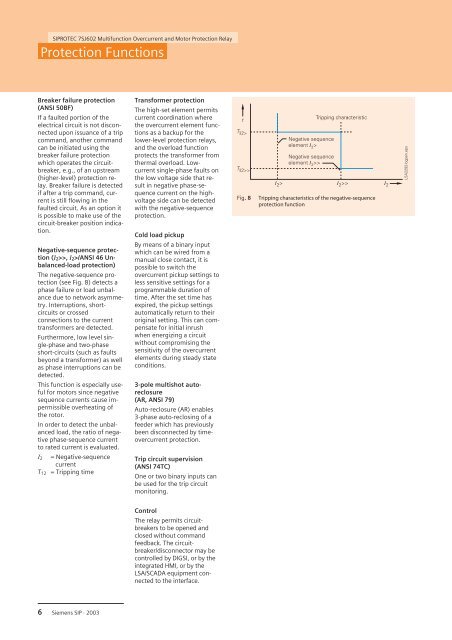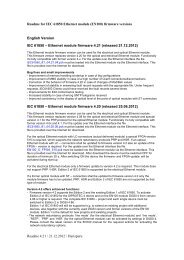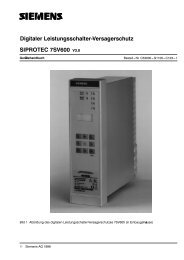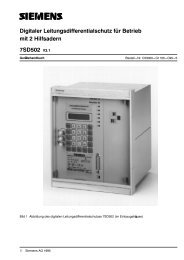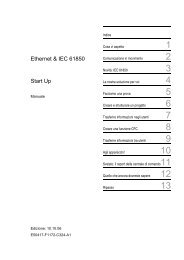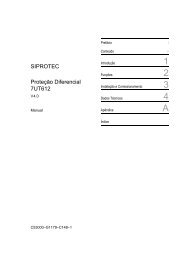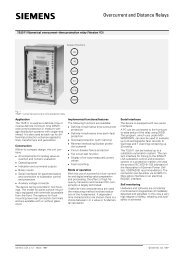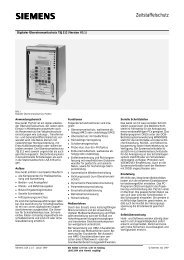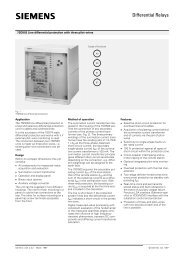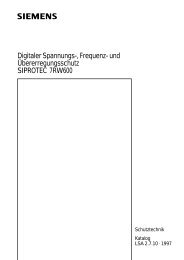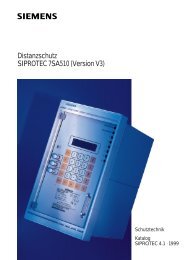SIPROTEC 7SJ602 Multifunction Overcurrent and Motor Protection ...
SIPROTEC 7SJ602 Multifunction Overcurrent and Motor Protection ...
SIPROTEC 7SJ602 Multifunction Overcurrent and Motor Protection ...
Create successful ePaper yourself
Turn your PDF publications into a flip-book with our unique Google optimized e-Paper software.
<strong>SIPROTEC</strong> <strong>7SJ602</strong> <strong>Multifunction</strong> <strong>Overcurrent</strong> <strong>and</strong> <strong>Motor</strong> <strong>Protection</strong> Relay<br />
<strong>Protection</strong> Functions<br />
Breaker failure protection<br />
(ANSI 50BF)<br />
If a faulted portion of the<br />
electrical circuit is not disconnected<br />
upon issuance of a trip<br />
comm<strong>and</strong>, another comm<strong>and</strong><br />
can be initiated using the<br />
breaker failure protection<br />
which operates the circuitbreaker,<br />
e.g., of an upstream<br />
(higher-level) protection relay.<br />
Breaker failure is detected<br />
if after a trip comm<strong>and</strong>, current<br />
is still flowing in the<br />
faulted circuit. As an option it<br />
is possible to make use of the<br />
circuit-breaker position indication.<br />
Negative-sequence protection<br />
(I2>>, I2>/ANSI 46 Unbalanced-load<br />
protection)<br />
The negative-sequence protection<br />
(see Fig. 8) detects a<br />
phase failure or load unbalance<br />
due to network asymmetry.<br />
Interruptions, shortcircuits<br />
or crossed<br />
connections to the current<br />
transformers are detected.<br />
Furthermore, low level single-phase<br />
<strong>and</strong> two-phase<br />
short-circuits (such as faults<br />
beyond a transformer) as well<br />
as phase interruptions can be<br />
detected.<br />
This function is especially useful<br />
for motors since negative<br />
sequence currents cause impermissible<br />
overheating of<br />
the rotor.<br />
In order to detect the unbalanced<br />
load, the ratio of negative<br />
phase-sequence current<br />
to rated current is evaluated.<br />
I2 = Negative-sequence<br />
current<br />
T12 = Tripping time<br />
6 Siemens SIP · 2003<br />
Transformer protection<br />
The high-set element permits<br />
current coordination where<br />
the overcurrent element functions<br />
as a backup for the<br />
lower-level protection relays,<br />
<strong>and</strong> the overload function<br />
protects the transformer from<br />
thermal overload. Lowcurrent<br />
single-phase faults on<br />
the low voltage side that result<br />
in negative phase-sequence<br />
current on the highvoltage<br />
side can be detected<br />
with the negative-sequence<br />
protection.<br />
Cold load pickup<br />
By means of a binary input<br />
which can be wired from a<br />
manual close contact, it is<br />
possible to switch the<br />
overcurrent pickup settings to<br />
less sensitive settings for a<br />
programmable duration of<br />
time. After the set time has<br />
expired, the pickup settings<br />
automatically return to their<br />
original setting. This can compensate<br />
for initial inrush<br />
when energizing a circuit<br />
without compromising the<br />
sensitivity of the overcurrent<br />
elements during steady state<br />
conditions.<br />
3-pole multishot autoreclosure<br />
(AR, ANSI 79)<br />
Auto-reclosure (AR) enables<br />
3-phase auto-reclosing of a<br />
feeder which has previously<br />
been disconnected by timeovercurrent<br />
protection.<br />
Trip circuit supervision<br />
(ANSI 74TC)<br />
One or two binary inputs can<br />
be used for the trip circuit<br />
monitoring.<br />
Control<br />
The relay permits circuitbreakers<br />
to be opened <strong>and</strong><br />
closed without comm<strong>and</strong><br />
feedback. The circuitbreaker/disconnector<br />
may be<br />
controlled by DIGSI, or by the<br />
integrated HMI, or by the<br />
LSA/SCADA equipment connected<br />
to the interface.<br />
Fig. 8 Tripping characteristics of the negative-sequence<br />
protection function


